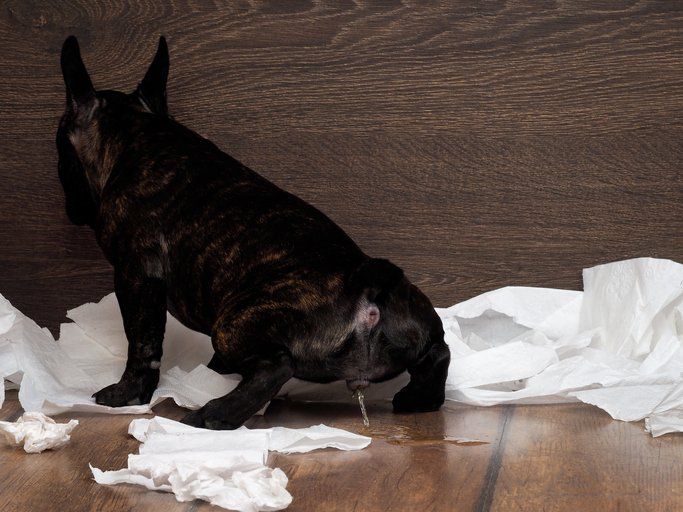Your female dog may be suddenly peeing in the house due to a urinary tract infection or a change in routine or environment. To address this issue, it’s important to consult with a veterinarian to rule out any medical causes and make any necessary behavior modifications.
Additionally, consider any recent changes in your dog’s surroundings or schedule that may be causing stress or anxiety. It’s also essential to maintain a consistent potty schedule and provide ample opportunities for your dog to relieve herself outside. Understanding the potential reasons for your dog’s sudden behavior and taking proactive steps can help address the issue effectively.
Key Causes Of Sudden Incontinence
Hormonal Imbalance Impact: Sudden incontinence in female dogs can be triggered by hormonal imbalances, especially as they age or experience reproductive changes.
Urinary Tract Infections (UTIs) Specifics: UTIs are a common cause of sudden incontinence in female dogs and can result in accidents inside the house.
Behavioral Triggers Identification: Changes in routine, environment, or stress levels can lead to sudden incontinence as a behavioral response in female dogs.
Medication Side Effects Overview: Some medications prescribed for female dogs may have side effects that include sudden incontinence, requiring close monitoring and potential adjustments.
Assessment And Diagnosis
It is essential to schedule regular veterinary visits to ensure your female dog’s overall health and well-being. Veterinary professionals utilize various diagnostic tools and tests to assess the underlying cause of sudden house soiling. Urinalysis reports play a crucial role in understanding the potential medical or behavioral issues contributing to your dog’s behavior. Differentiating between these factors is vital in devising an appropriate treatment plan tailored to your dog’s specific needs.
Medical Interventions For Urinary Issues
If your female dog is suddenly peeing in the house, it could be a sign of urinary issues that require medical intervention. Prescription options for urinary tract infections (UTIs) may include antibiotics and anti-inflammatory medications to address the underlying infection. Hormone therapy can be used to manage spay incontinence in female dogs, helping to regulate urinary control. In some cases, surgery may be necessary to address anatomical abnormalities that contribute to urinary problems. Consulting a veterinarian is crucial to determine the most appropriate medical intervention for your dog’s specific urinary issue.
Behavioral And Environmental Adjustments
House training refresher tips: Ensure your female dog’s house training is still on track by providing frequent bathroom breaks, especially after meals, playtime, and naps. Reinforce positive behavior with treats and praise.
Stress reduction techniques for dogs: Identify stress triggers and work towards minimizing them. Provide plenty of exercise, mental stimulation, and a safe space for your dog. Consider using calming aids or seeking professional help if needed.
Modifying the dog’s environment: Create a predictable routine to reduce anxiety. Keep the environment clean and free from potential stressors. Implement changes gradually and monitor the impact on your dog’s behavior.
Proactive Health Measures
Female dogs may sometimes start peeing inside the house due to various health issues. In order to prevent this, it is important to consider a few proactive health measures. Diet and nutrition play a critical role in maintaining urinary health. Additionally, ensuring that the dog gets regular exercise is beneficial. It is also important to schedule consistent bathroom breaks to avoid accidents in the house. By paying attention to these proactive health measures, it is possible to address the issue of sudden peeing in the house and promote the well-being of female dogs.

Credit: toegrips.com
Monitoring Health Post-treatment
It’s important to monitor your female dog’s behavior closely if she starts suddenly peeing in the house. After treatment, it’s crucial to provide follow-up care post-diagnosis of any underlying health issues. Recognizing recurrence signs early can help in providing timely medical intervention. Regular vet check-ups can also aid in keeping track of your dog’s health post-treatment, ensuring proper care and attention.
Strengthening Owner-dog Bond
Strengthening Owner-Dog Bond
Communication and understanding
When female dogs suddenly start peeing in the house, it can be a sign of communication breakdown or a health issue. Building a strong bond with your dog through regular walks, playtime, and positive reinforcement can help address this behavior. Understanding your dog’s body language and cues can also help identify any underlying issues causing the behavior. Establishing routines and consistency in feeding times, potty breaks, and exercise can help create a sense of security and stability for your dog, reducing the likelihood of indoor accidents.
Essential Housekeeping Strategies
Female dogs may suddenly start peeing in the house due to various reasons, including medical issues, anxiety, or marking territory. Proper housekeeping strategies are essential to address this behavior. Begin by thoroughly cleaning any soiled areas with an enzymatic cleaner to eliminate odors that may encourage repeat markings. Implement deterrents such as using dog diapers or indoor potty options to prevent further accidents. Consistency in cleaning and providing alternative elimination methods can help modify this behavior and ensure a cleaner living space for both you and your furry friend.
Frequently Asked Questions On Why Is My Female Dog Suddenly Peeing In The House
Why Is My Female Dog Suddenly Peeing In The House?
Female dogs may start peeing inside due to urinary tract infections, hormonal changes, anxiety, or territorial marking. It’s essential to consult a vet to rule out any medical issues and address any behavioral or environmental triggers causing this sudden change in behavior.
What Can I Do To Stop My Female Dog From Peeing Indoors?
To prevent indoor peeing, ensure your dog has frequent bathroom breaks, implement positive reinforcement training, clean up accidents using an enzymatic cleaner, and create a comfortable and stress-free environment. Consistency in routine, patience, and understanding are key to successfully addressing this issue.
Can Spaying My Female Dog Help With Indoor Peeing Behavior?
Spaying can reduce territorial marking and eliminate the risk of some health issues that may cause indoor peeing behavior. However, it’s essential to consult with a veterinarian to determine if spaying is the appropriate course of action for your individual dog’s behavior and health needs.
Conclusion
Understanding the reasons behind your female dog’s sudden indoor peeing is essential. By identifying potential triggers such as stress, medical issues, or territorial behavior, you can take appropriate steps to address the problem. Consulting with a veterinarian and providing consistent training and a safe environment are crucial in resolving this issue.



